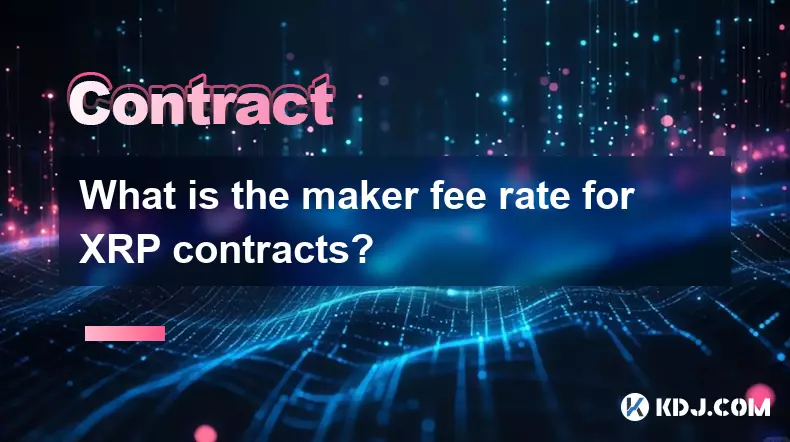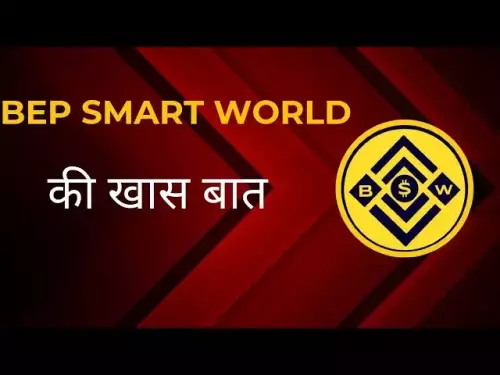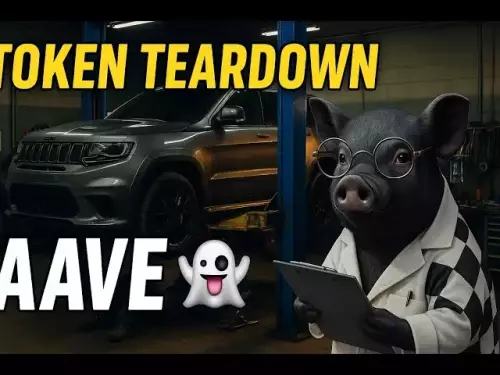-
 bitcoin
bitcoin $112195.049338 USD
2.42% -
 ethereum
ethereum $4124.915858 USD
2.81% -
 tether
tether $1.000570 USD
0.02% -
 xrp
xrp $2.861568 USD
2.25% -
 bnb
bnb $1000.346670 USD
3.04% -
 solana
solana $209.070819 USD
3.38% -
 usd-coin
usd-coin $0.999870 USD
0.02% -
 dogecoin
dogecoin $0.235379 USD
2.65% -
 tron
tron $0.335681 USD
-0.20% -
 cardano
cardano $0.803501 USD
3.38% -
 hyperliquid
hyperliquid $47.120881 USD
3.56% -
 chainlink
chainlink $21.501300 USD
3.44% -
 ethena-usde
ethena-usde $1.000571 USD
0.02% -
 avalanche
avalanche $29.793378 USD
3.62% -
 stellar
stellar $0.366964 USD
2.42%
What is the maker fee rate for XRP contracts?
Maker fees for XRP contracts typically range from 0.00% to 0.05%, with top exchanges like Binance and Bybit offering reduced or zero fees for high-volume traders.
Sep 29, 2025 at 12:18 am

Understanding Maker Fee Rates in XRP Contracts
1. The maker fee rate for XRP contracts on most major cryptocurrency derivatives exchanges typically ranges between 0.02% and 0.05%. These fees apply when traders place limit orders that add liquidity to the order book, meaning their orders do not execute immediately but wait to be matched.
2. Exchanges such as Binance, Bybit, and OKX often maintain competitive fee structures for perpetual and futures contracts involving XRP. For example, Binance Futures generally charges a maker fee of 0.02% for both USDT-margined and COIN-margined XRP contracts under standard fee tiers.
3. Traders with higher 30-day trading volumes may qualify for lower maker fee rates through tiered fee systems. Volume-based rebates or VIP programs can reduce the maker fee to as low as 0.00%, effectively making market-making activity cost-free for elite-tier users.
4. It is essential to distinguish maker fees from taker fees, which are usually higher. While maker fees reward liquidity provision, taker fees are charged when an order removes liquidity by matching existing orders instantly.
5. Fee structures may vary depending on the contract type—whether it's linear (USDT-settled) or inverse (XRP-settled). Inverse contracts might carry slightly different fee dynamics due to settlement in the base asset rather than stablecoins.
Key Factors Influencing XRP Contract Fees
1. Exchange policy plays a central role in determining maker fee rates. Each platform independently sets its fee schedule based on business strategy, competition, and user acquisition goals.
2. User tier levels significantly affect the final fee paid. Most platforms use a tier system where users with greater trading volume or higher account balances receive preferential rates, including reduced or zero maker fees.
3. Promotional campaigns or exchange-specific incentives sometimes offer temporary reductions or full waivers on maker fees for certain pairs, including XRP contracts, to stimulate trading activity.
4. The funding rate mechanism in perpetual contracts does not directly impact maker fees but influences overall trading costs. High funding rates can offset the benefit of low maker fees over time, especially for long-term positions.
5. Geographic location may also influence fee application due to regulatory requirements. Some jurisdictions require exchanges to impose additional compliance-related charges or restrict access to discounted fee programs.
Comparing Major Platforms Offering XRP Derivatives
1. Binance Futures applies a standard 0.02% maker fee across both USDT and BUSD-margined XRP/USDT perpetual contracts. Users in VIP tiers 1–9 enjoy progressively lower rates, with the highest tiers reaching 0.00%.
2. Bybit maintains a consistent 0.01% maker fee for XRPUSD perpetual contracts, positioning itself as one of the more cost-efficient platforms for liquidity providers trading XRP derivatives.
3. OKX lists a base maker fee of 0.02% for XRP-USDT swaps, aligning closely with industry standards. Volume-based discounts allow eligible traders to reduce this further, even achieving negative fees in rare cases via rebate programs.
4. KuCoin Futures charges a 0.02% maker fee on XRP/USDT contracts, matching other top-tier exchanges. Its tiered model rewards users who hold KCS tokens, offering incremental fee reductions tied to token balance.
5. Bitget follows a similar structure with a 0.02% standard maker fee, while providing additional incentives through its 'Big Trader' program, which allows followers of successful traders to share in fee benefits indirectly.
Frequently Asked Questions
What is the difference between a maker and a taker in crypto futures trading?A maker places a limit order that adds liquidity to the market by waiting to be filled. A taker places an order that executes immediately against existing orders, removing liquidity. Makers usually pay lower fees—or none at all—while takers incur higher fees.
Can I trade XRP contracts with zero maker fees?Yes, certain exchanges offer zero or negative maker fees for high-volume traders. On platforms like Binance or Bybit, users in the highest VIP tiers may receive 0.00% maker fees or even earn rebates for providing liquidity on XRP contracts.
Do maker fees vary between isolated and cross margin modes?No, maker fees are independent of margin mode selection. Whether using isolated or cross margin, the fee rate applied depends only on the user’s tier level and the exchange’s fee schedule, not the margin configuration.
Are there hidden costs associated with XRP contract trading beyond maker fees?Beyond maker and taker fees, traders should consider funding payments in perpetual contracts, withdrawal fees, and potential liquidation penalties. While not direct transaction fees, these costs contribute to the total expense of maintaining positions in XRP derivatives.
Disclaimer:info@kdj.com
The information provided is not trading advice. kdj.com does not assume any responsibility for any investments made based on the information provided in this article. Cryptocurrencies are highly volatile and it is highly recommended that you invest with caution after thorough research!
If you believe that the content used on this website infringes your copyright, please contact us immediately (info@kdj.com) and we will delete it promptly.
- Solana: Institutions' Growing Confidence Signals a Bullish Future
- 2025-09-29 17:05:16
- PumpFun (PUMP) Price in October: Will the Memecoin Momentum Continue?
- 2025-09-29 16:25:14
- Cloud Mining, High-Yield Contracts, and Market Volatility: A New Yorker's Take
- 2025-09-29 17:05:16
- Royal Mint Error Coins: What's the Sell Price?
- 2025-09-29 16:25:14
- BABY Token Inflation and Co-Staking: A New Era for Babylon
- 2025-09-29 17:10:01
- Dogecoin, ETFs, and Memecoins: Navigating the Hype in the Wild World of Crypto
- 2025-09-29 17:10:01
Related knowledge

How do I use the scheduled order feature in Cardano (ADA) contracts?
Sep 28,2025 at 10:18pm
Understanding Scheduled Orders in Cardano Smart ContractsCardano operates on a proof-of-stakes consensus mechanism and uses the Plutus scripting langu...

How do I enable the "scalping-only" mode for Cardano (ADA) contracts?
Sep 24,2025 at 03:19am
Understanding Scalping Strategies in Crypto Derivatives1. Scalping in cryptocurrency trading refers to executing multiple short-term trades within min...

What is the settlement time for Cardano (ADA) contracts?
Sep 28,2025 at 04:18am
Understanding Cardano's Contract Settlement Mechanism1. Cardano operates on a proof-of-stake consensus model known as Ouroboros, which fundamentally i...

How do I add margin to Cardano (ADA) contracts?
Sep 27,2025 at 07:54pm
Understanding Margin in Cardano (ADA) Smart ContractsCardano operates on a proof-of-stake blockchain that supports smart contracts through its Plutus ...

What is the maximum position limit for Cardano (ADA) contracts?
Sep 23,2025 at 11:00pm
Understanding ADA Futures and Derivatives Market Structure1. Cardano (ADA) futures contracts are offered by several major cryptocurrency derivatives e...

What is the maker fee for Cardano (ADA) contracts?
Sep 26,2025 at 09:01am
Understanding Maker Fees in Cardano (ADA) Contracts1. The concept of maker fees applies broadly across decentralized exchanges and smart contract plat...

How do I use the scheduled order feature in Cardano (ADA) contracts?
Sep 28,2025 at 10:18pm
Understanding Scheduled Orders in Cardano Smart ContractsCardano operates on a proof-of-stakes consensus mechanism and uses the Plutus scripting langu...

How do I enable the "scalping-only" mode for Cardano (ADA) contracts?
Sep 24,2025 at 03:19am
Understanding Scalping Strategies in Crypto Derivatives1. Scalping in cryptocurrency trading refers to executing multiple short-term trades within min...

What is the settlement time for Cardano (ADA) contracts?
Sep 28,2025 at 04:18am
Understanding Cardano's Contract Settlement Mechanism1. Cardano operates on a proof-of-stake consensus model known as Ouroboros, which fundamentally i...

How do I add margin to Cardano (ADA) contracts?
Sep 27,2025 at 07:54pm
Understanding Margin in Cardano (ADA) Smart ContractsCardano operates on a proof-of-stake blockchain that supports smart contracts through its Plutus ...

What is the maximum position limit for Cardano (ADA) contracts?
Sep 23,2025 at 11:00pm
Understanding ADA Futures and Derivatives Market Structure1. Cardano (ADA) futures contracts are offered by several major cryptocurrency derivatives e...

What is the maker fee for Cardano (ADA) contracts?
Sep 26,2025 at 09:01am
Understanding Maker Fees in Cardano (ADA) Contracts1. The concept of maker fees applies broadly across decentralized exchanges and smart contract plat...
See all articles










































































